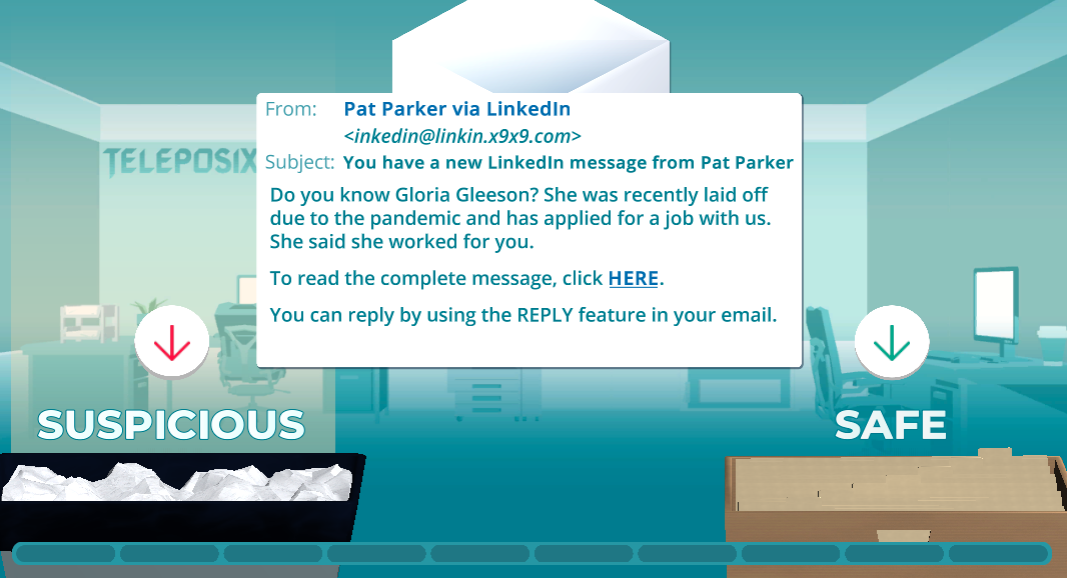
How Click Armor's thought-provoking interactivity engages end-users to learn about cyber security and compliance risks
You’ve probably experienced it yourself when going through an online course that isn’t one of your personal top priorities. You drift off as you scan a wall of text and click on the “Next” button…
Or you look for the “fast forward” button on the cute video that seems well-produced, but is forcing you to endure a narrative that doesn’t seem to be telling you anything most of the time.
…And then, you reach the inevitable quiz at the send of the module, in which you look for the most obvious answer to a question that has limited plausible options. You just want to get to the magical, minimal passing threshold, and return to the work you care about.
This predictable and onerous gauntlet is the curse of traditional awareness training programs built for traditional learning management systems. Or worse, the training may simply be displayed in a gallery of videos. They call it “self-paced” learning, but it isn’t really either one – self-paced or learning. You feel like you’ve been wasting time you’ll never get back.
How much thought has been put into making your awareness training truly engaging for students?
Most instructional designers are very qualified to create effective training courses. Many will also know how to add engaging elements. In fact, it was easier for them to create engaging, “self-paced” training courses in the days of the old “CD-ROM” publishing packages.
For example, one of the most creative and engaging “self-paced” learning programs I remember from being a parent was “The Magic School Bus” series of CD-ROM games developed by Music Pen and distributed by Microsoft. These learning games were playable on your home computer. There were interesting “clickable” areas that would take you into a whole new screen where you could play a mini-game to learn and practice.
One of the reasons most corporate training programs aren’t this engaging today is because of the trend toward using low-cost programs deployed on low-cost learning management systems (LMS). These platforms use a standard user interface, and have limited ability to deliver content that has a highly engaging user experience like The Magic Schoolbus.
The need for balance between engagement and efficiency in awareness training
Another reason that corporate awareness training isn’t as engaging as the Magic School Bus games involves the need for corporate “efficiency”. Although the CD-ROM learning games were certainly capable of being entertaining and educational, businesses now find it very hard to justify the use of a highly exploratory learning program when it isn’t in the vein of an employee’s primary role – the one for which they are evaluated and compensated (…we can talk about incentives for working securely in another article). They just don’t want employees spending more time away from the jobs they were hired for, as it would impact their short term productivity. And to date, managers haven’t seen concrete evidence that the training will make them more productive in the short or long term (…again, a topic for another blog post).
So, that’s why I designed the Click Armor gamified awareness platform to be engaging, but also efficient. There is a balance between the use of game mechanics that entices end-users to learn through exploration at their own pace, and a time-efficient framework that allows them to complete a learning program quickly.
Here are just a few examples of how we find that balance…
First, we use almost no “static content” in most of our courses, which is typically easy for people to skim over. They only need to read small amounts of text before they are forced to think about the next action they need to take.
There are animations that grab users’ attention in ways they don’t see in traditional training programs, making the experience visually dynamic.
Students can obtain a different score based on their engagement, but their overall score correlates to the amount they have actually learned. So, the experience is less predictable than a traditional awareness training program.
You can get an idea of what this experience looks like for free by trying our gamified phishing awareness self-assessment called “Can I Be Phished?” You can access it without any registration at: https://clickarmor.ca/canibephished
For a more detailed exploration of the features and capabilities of a platform that was truly designed for engaging end-users, students or employees, please schedule a call

